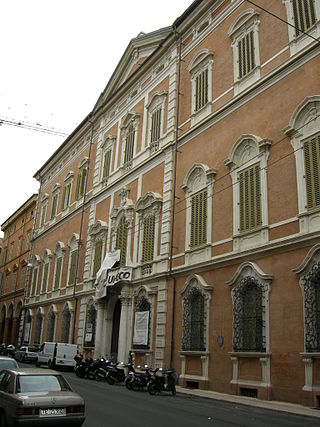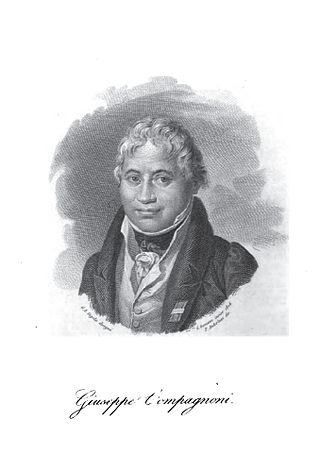
Reggio nell'Emilia, usually referred to as Reggio Emilia, or simply Reggio by its inhabitants, and known until 1861 as Reggio di Lombardia, is a city in northern Italy, in the Emilia-Romagna region. It has about 171,944 inhabitants and is the main comune (municipality) of the Province of Reggio Emilia.

Forlì is a comune (municipality) and city in Emilia-Romagna, Northern Italy, and is the capital of the province of Forlì-Cesena. It is the central city of Romagna.

The Music of Emilia-Romagna has the reputation of being one of the richest in Europe; there are six music conservatories alone in the region, and the sheer number of other musical venues and activities is astounding. The region, as the name implies, combines the traditions of two different, contiguous areas—Emilia and Romagna—and it is perhaps this blend that contributes to the wealth of musical culture.

The Archdiocese of Bologna is a Latin Church ecclesiastical territory or archdiocese of the Catholic Church in Northern Italy. The cathedra is in the cathedral church of San Pietro, Bologna. The current archbishop is Cardinal Matteo Zuppi, who was installed in 2015.

Santa Sofia is a comune (municipality) in the Province of Forlì-Cesena in the Italian region Emilia–Romagna, located about 80 kilometres (50 mi) southeast of Bologna and about 35 kilometres (22 mi) southwest of Forlì. The municipality of Santa Sofia is located in the Bidente river valley and is surrounded by the Foreste Casentinesi, Monte Falterona, Campigna National Park.
Emilia is a historical region of northern Italy, which approximately corresponds to the western and the north-eastern portions of the modern region of Emilia-Romagna, with the area of Romagna forming the remainder of the modern region.

Bologna is a city in and the capital of the Emilia-Romagna region in Northern Italy, of which it is also its largest. It is the seventh most populous city in Italy, with about 400,000 inhabitants and 150 different nationalities. Its metropolitan area is home to more than 1,000,000 people. It is known as the Fat City for its rich cuisine, and the Red City for its red tiled rooftops and, more recently, its leftist politics. It is also called the Learned City because it is home to the oldest university in the world.

The Fiera di Bologna is the business district of the city of Bologna, in central Italy. The area includes a trade exhibition centre and several office towers occupied by the regional government of Emilia-Romagna and various private companies.

The Palazzo Aldovrandi is a Senatorial palace on Via Galliera 8 in Bologna, built in Rococo style.
Santa Maria della Carità is a Renaissance-style Roman Catholic church in central Bologna, Italy.

The Civic Museum of the Risorgimento is located in the ground floor of the Casa Carducci, located in Piazza Carducci 5, in central Bologna, Italy.
The International Composition Competition "2 Agosto" is a major composition competition in Italy. It was established in 1994 at the behest of the Association of the families of the victims of the massacre at Bologna Station on August 2, 1980.
The following is a timeline of the history of the city of Parma in the Emilia-Romagna region of Italy.
The following is a timeline of the history of the city of Forlì in the Emilia-Romagna region of Italy.
The following is a timeline of the history of the city of Piacenza in the Emilia-Romagna region of Italy.

The Bologna tramway network was an important part of the public transport network of Bologna, Italy. It was established in 1880 and discontinued in 1963.

The cockade of Italy is the national ornament of Italy, obtained by folding a green, white and red ribbon into a plissé using the technique called plissage (pleating). It is one of the national symbols of Italy and is composed of the three colours of the Italian flag with the green in the centre, the white immediately outside and the red on the edge. The cockade, a revolutionary symbol, was the protagonist of the uprisings that characterized the Italian unification, being pinned on the jacket or on the hats in its tricolour form by many of the patriots of this period of Italian history. During which, the Italian Peninsula achieved its own national unity, culminating on 17 March 1861 with the proclamation of the Kingdom of Italy. On 14 June 1848, it replaced the azure cockade on the uniforms of some departments of the Royal Sardinian Army, while on 1 January 1948, with the birth of the Italian Republic, it took its place as a national ornament.

Marco Giuseppe Compagnoni was an Italian constitutionalist, writer and journalist, considered the "father of the Italian flag", since he was the first to propose the official use of the Italian tricolour for the flag of a sovereign Italian state, the Cispadane Republic, on 7 January 1797.

The Sardines movement, also known as Sardines against Salvini, was a grassroots political movement, which began in Italy in November 2019.

Filippo Zamboni was an Italian poet and writer.



















